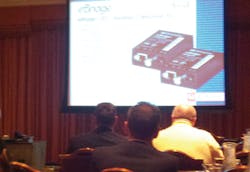Say the name Altronix and most security integrators think power supplies. According to the firm's president and founder Alan Forman, there was a time when that also meant power supplies for analog products. It was what built Altronix – a U.S. firm that actually still makes its products in the United States – into the formidable company it is today.
But being one of the dominant players for powering analog devices wasn't where Forman and his team were ready to stop. The company has been steadily rebuilding its product line by adding solutions that (please pardon the pun) empower the transition to network technologies via power support and transmission technologies.
Take the NetWay product for example. Scheduled for launch the middle of next month but previewed at an ISC West press conference, this is a midspan PoE injector that will all provide up to 85 watts of power for IP devices. Those 85 watts comes from a partnership with Linear Technology to deploy what the industry is beginning to call PoE++. That's a technology that builds off the current PoE+ standard (IEEE 802.3at-2009) which loads about 25 watts over a standard Ethernet line. The PoE++ designation means that the "plus plus" supports up to 85 watts. It's not a standard yet like the IEEE support 802.3at, but many in the industry are already pushing it that way, and the availability of this product from Altronix means that industry support should assist the standards process that is expected. What do you need 85 Watts for? Think of things like high-power drawing PTZ cameras with fans and heaters that might even incorporate radio communicators.
On the same token of heading toward IP, Altronix is out with the eBridge series of products. This is a product line that supports the move to put Ethernet communications over coaxial cable. Coaxial cable having been deployed for years as part of analog video surveillance camera systems, this technology leverages that existing cabling infrastructure and puts IP cameras over coaxial line. One of the real advantages (besides not having to rip out old cabling and install new Ethernet) is that these receiver transceiver pairs allow singles runs of 1,500 feet over standard coax, versus the maximum recommended distance of 328 feet on a single Ethernet cable. Combined with an IP camera and Ethernet on each end of the transceiver pairs, you're looking at over 2,000 foot runs for data lines (328ft from camera to transceiver via Ethernet, 1500ft from transceiver to receiver in coax, and another 328ft from receiver to recording unit via Ethernet). There are single camera units as well as a 16 channel receiver unit, and 4- and 8-channel units are on the way. The product works exceptionally well with Sony's new hybrid solutions, which have an Intersil chip that allows the Sony IPELA hybrid IP cameras (also with Intersil chips) to put the network signal directly onto the old coax, requiring only a receiver at the other end of the line – thus eliminating one piece of hardware.
Altronix is also rolling out some revisions of existing products. A new RE2 rack-mounted battery enclosure puts batteries in rack space rather than sitting on a shelf. The eFlow product offers a single output power supply with supervision and other advanced features and the FireSwitch pushes fire alarm system powering further than you've seen before.
All in all, it's a sign that Altronix is in step with the IP video revolution and is staying ahead of the product development curve.




